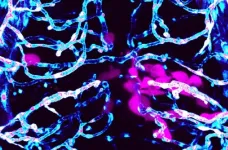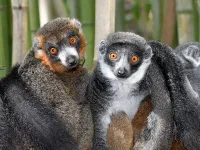T cells depressed
2021-02-12
(Press-News.org) T lymphocytes, or T cells, are an important component of our immune system. They can recognize foreign proteins, so-called antigens, as peptide fragments - for instance, those derived from viruses or cancer cells. In principle, they could, but usually do not, attack our own ('self') proteins. "That is why it is important for the organism to tightly control the activities of T cells," says Dr. Reinhard Obst, head of a research group at the Institute for Immunology at LMU's Biomedical Center that studies the activation of T cells. The project contributed to the Collaborative Research Center 1054 that explores the plasticity of cell fate decisions in the immune system.
When viruses gain access to our tissues, T cells are activated to eliminate the pathogens. However, if T cells are exposed to their target antigens for too long, they can lose their functionality and become 'exhausted.' They no longer secrete pro-inflammatory messenger molecules, and therefore cannot contribute much to an immune response. On the one hand, it makes sense to keep these cells under control, so as to avoid collateral damage to the organism. On the other, T cell exhaustion makes it difficult to fight chronic diseases, such as those caused by HIV, hepatitis viruses and cancer cells. Understanding immune responses to chronically persisting threats like these is thus one of modern medicine's great challenges. "This is where T cell exhaustion plays a central role." the LMU researcher says.
A new model to study T cell exhaustion
Several years ago, Obst developed an animal model which has now yielded important insights. He focused on T helper cells, which express the CD4 marker molecule and make up the largest subset of T cells. Each of these cells recognizes a defined protein fragment as an antigen.
To control the timing and the amount of the specific antigen expressed in this model system, the LMU scientists used a trick. Their transgenic mice were exposed to different doses of the antibiotic doxycycline, which controls the synthesis of the antigen, via their drinking water. Different amounts of antigen are thus being presented to the T cells in these animals, which avoids the need for experimental infection. "In this way, we are able to regulate the amount of antigen produced," Obst explains. "Our goal was to find out how the corresponding T helper cells respond.
The results showed that the effects were dose dependent: In the presence of high antigen doses, the T cells underwent apoptosis, meaning they died by programmed cell death. At an intermediate dose, however, the T cells survived but quickly lost their functionality. "We demonstrated this state of exhaustion by regulating the amount of antigen that the cells encountered," the LMU researcher explains. At a low dose, it took several weeks before the cells showed signs of exhaustion. When in further experiments the antigen was subsequently removed, the cells were able to partially recover from their exhausted state. Such dynamic adjustments convinced the researchers that T-helper cells are capable of a surprising degree of plasticity.
Supporting the T cells' fight against chronic infections and cancer
Obst and his colleagues believe that their findings could have therapeutic implications. The data indicate that a number of transcription factors (proteins that control gene expression) and signaling pathways regulate the different states of exhaustion.
Two years ago, several groups showed that one of these transcription factors, named Tox, contributes significantly to the exhaustion of T killer cells, another T cell subset. When the Tox gene was deleted, the T-killer cells were less readily exhausted in a chronic infection and could more effectively fight a chronically persisting virus. However, they also attacked the host animals' organs and died sooner. The new findings suggest that there are several mechanisms in place to adjust T helper cells dynamically to different antigen loads.
Obst now hopes to identify molecules that inhibit transcription factors or signaling pathways which contribute to T cell exhaustion. This could provide a possible strategy to support T cells' fight against chronic infections and cancer and boost our natural defences against such diseases.
INFORMATION:
ELSE PRESS RELEASES FROM THIS DATE:
2021-02-12
Scientists use many different tests to investigate what happens in the brain in people experiencing stress. It is unclear to what extent the various methods with which subjects are placed under stress are comparable to each other. In a meta-analysis, a biopsychology team from Ruhr-Universität Bochum compared 31 previous studies that had investigated stress using functional magnetic resonance imaging (fMRI). The team worked out which regions of the brain are activated as standard during stress and which stress tests trigger similar activation patterns. They describe the results in the journal Neuroscience and Biobehavioral Reviews, published online on 5 February 2021.
To conduct the work, ...
2021-02-12
The move from the ancient system of £sd coinage to 100p to £1 was controversial, considered by some to be a sign of the UK's receding importance on the world stage and even as the beginning of the tumultuous relationship with Europe that ultimately led to Brexit.
But as a result of extensive analysis of a quiet backwater of recent history, Andy argues that the move towards decimalisation had little to do with Europe and in fact was a traditional British compromise.
"It was an event that I remember from my youth, but I found that ...
2021-02-12
Biomarkers play a central role in the diagnosis of disease and assessment of its course. Among the markers now in use are genes, proteins, hormones, lipids and other classes of molecules. Biomarkers can be found in the blood, in cerebrospinal fluid, urine and various types of tissues, but most of them have one thing in common: They occur in extremely low concentrations, and are therefore technically challenging to detect and quantify.
Many detection procedures use molecular probes, such as antibodies or short nucleic-acid sequences, which are designed to bind to specific biomarkers. When a probe recognizes and binds to its target, chemical or physical reactions give rise to fluorescence signals. Such methods work well, provided they are sensitive enough to recognize ...
2021-02-12
Knowledge on how cells communicate is an important key to understanding many biological systems and diseases. A research team led by researchers at the University of Gothenburg has now used a unique combination of methods to map the mechanism behind cellular communication. Their findings can potentially improve understanding of the underlying mechanism behind type 2 diabetes.
We know that human communication is important, but communication between the cells in our bodies is just as vital. The processes where cells synchronize and coordinate their behaviour is required for an organism to function and for human organs to be able to perform their functions.
"How do cells go from monologues ...
2021-02-12
Scientists at the Fralin Biomedical Research Institute at VTC have identified a new zebrafish model that could help advance glioblastoma multiforme research. Glioblastoma is an aggressive form of primary brain tumor - fewer than one in 20 patients survive five years after diagnosis.
The research team previously discovered that human-derived brain cancer cells in mice use the brain's blood vessels like highways to spread away from the original mass. In the new study, published in ACS Pharmacology and Translational Science, they show clear cross-over between mammals and fish and describe similar observations in zebrafish.
"Our hope is that this new work in zebrafish will help researchers ...
2021-02-12
COLUMBUS, Ohio - On the outskirts of some small Indigenous communities in the Mexican state of Oaxaca, a few volunteer guards keep watch along roads blocked by makeshift barricades of chains, stones and wood.
The invader they are trying to stop is COVID-19.
For many of Mexico's Indigenous people, poor and ignored by state and federal governments, the fight against the COVID-19 pandemic is one that rests primarily with themselves, said Jeffrey Cohen, a professor of anthropology at The Ohio State University.
That means they must take steps like limiting access to their villages.
"Most of these communities only have ...
2021-02-12
peer review/experimental study/animals/cells
Researchers from Uppsala University show in a new study that inhibition of the protein EZH2 can reduce the growth of cancer cells in the blood cancer multiple myeloma. The reduction is caused by changes in the cancer cells' metabolism. These changes can be used as markers to discriminate whether a patient would respond to treatment by EZH2 inhibition. The study has been published in the journal Cell Death & Disease.
Multiple myeloma is a type of blood cancer where immune cells grow in an uncontrolled way in the bone marrow. The disease is very difficult to treat and is still considered incurable, and thus it is urgent to identify new therapeutic targets in the cancer cells.
The research group behind ...
2021-02-12
TROY, N.Y. -- An antioxidant found in green tea may increase levels of p53, a natural anti-cancer protein, known as the "guardian of the genome" for its ability to repair DNA damage or destroy cancerous cells. Published today in Nature Communications, a study of the direct interaction between p53 and the green tea compound, epigallocatechin gallate (EGCG), points to a new target for cancer drug discovery.
"Both p53 and EGCG molecules are extremely interesting. Mutations in p53 are found in over 50% of human cancer, while EGCG is the major anti-oxidant in green tea, a popular beverage worldwide," said END ...
2021-02-12
DURHAM, N.C. -- Humans aren't the only mammals that form long-term bonds with a single, special mate -- some bats, wolves, beavers, foxes and other animals do, too. But new research suggests the brain circuitry that makes love last in some species may not be the same in others.
The study, appearing Feb. 12 in the journal Scientific Reports, compares monogamous and promiscuous species within a closely related group of lemurs, distant primate cousins of humans from the island Madagascar.
Red-bellied lemurs and mongoose lemurs are among the few species in the lemur family tree in which male-female partners stick together year after year, working together to raise their young and defend their territory.
Once bonded, pairs spend much of their waking hours grooming ...
2021-02-12
Every year around 20 Australian children die from the incurable brain tumour, Diffuse Intrinsic Pontine Glioma (DIPG). The average age of diagnosis for DIPG is just seven years. There are no effective treatments, and almost all children die from the disease, usually within one year of diagnosis.
A paper published today 12 Feb 2021 in the prestigious journal, Nature Communications, reveals a potential revolutionary drug combination that - in animal studies and in world first 3D models of the tumour - is "spectacularly effective in eradicating the cancer cells," according to lead researcher and paediatric oncologist Associate Professor David Ziegler, from the Children's Cancer Institute and Sydney Children's Hospital.
In ...
LAST 30 PRESS RELEASES:
[Press-News.org] T cells depressed






